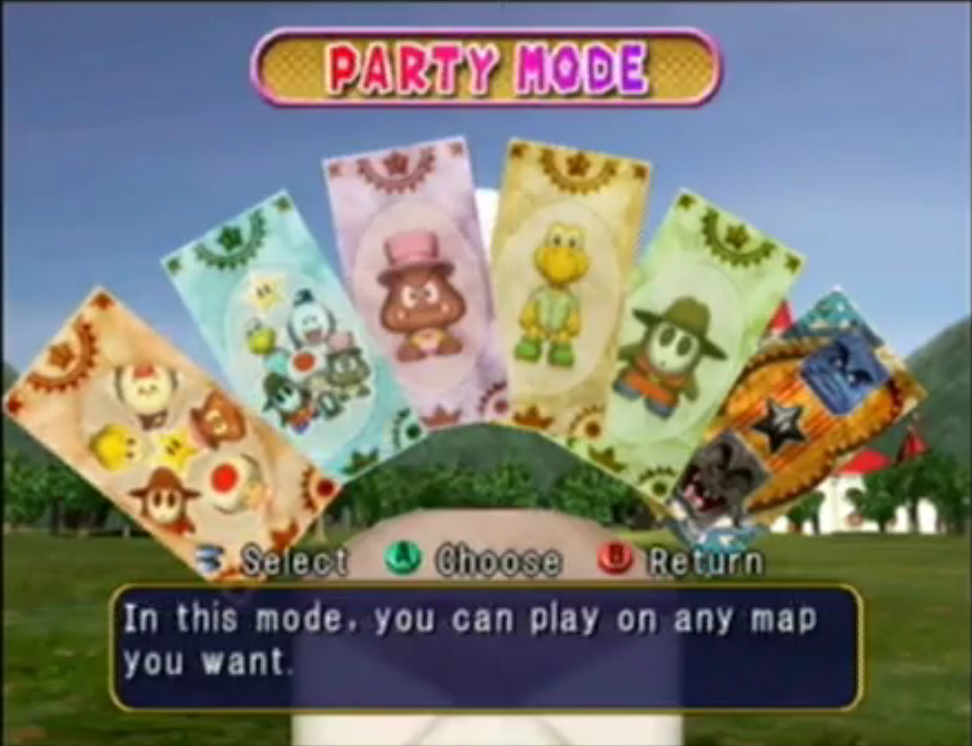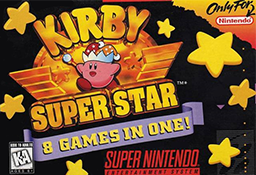It is hard to bridge the gap between Kirby Super Star’s impact on me as a modern player and how I might imagine it made an impact on players when it was released in 1996. From my research on the game, it seems that Kirby Super Star trailblazed and innovated elements of game structure and gameplay; upon release, it was widely celebrated as new and exciting. The basic structure of Kirby Super Star–and part of what made it so compelling at the time–is that it is a collection of different platformer storylines within a single game, as well as additional minigames. To this day, it is still widely celebrated and enjoyed as one of the best Kirby games.
In my experience playing the game, I did find it entertaining, but didn’t find it all that groundbreaking. But I say this with a caveat; it is impossible to extract myself from my experience of playing games that Kirby Super Star may have influenced (games that came to mind while playing include Paper Mario: The Thousand Year Door and Super Monkey Ball 2, which I will discuss more in depth later); so, when I took a stab at playing myself, experiences with the game that may have felt revolutionary, new, or exciting in 1996 felt familiar and run-of-the-mill to me. Having this experience with Kirby Super Star reminds me of the tragedy of The Great Gatsby. While it is a beautiful piece of literature that is well-presented, creative, and compelling, its influence on preceding literature and widespread popularity has caused it to become overdone in a sense. It was the success of The Great Gatsby that turned it into a cliché. I do not think the success of Kirby Super Star has tainted it in such a severe way as The Great Gatsby (it is still a solid game and can be fun), but this observation does beg the question: how does playing a groundbreaking classic after the fact of playing later games that were influenced by its innovations affect the gaming experience?
Kirby Super Star has five main games that cover a variety of gameplay (classic platforming, racing a CPU through a platformer, exploring the map and finding treasure, etc.) plus additional mini games. This was a big deal in 1996; Kirby Super Star broke the form of a “game” being contained within a single set of mechanics and a single storyline, which wasn’t common at the time.

I can attempt to understand the gravity of this innovation, but I can never truly feel it myself. From a 2021 perspective, or even a mid-2000’s perspective, this doesn’t impress me as a player. I mean absolutely no disrespect to Kirby Super Star. I have just been desensitized to an innovation that was once so stimulating. I grew up playing Super Monkey Ball 2, Mario Party 4 & 5, and Pokémon Stadium 2. All of these games include a multitude of different gameplay options within their structure.



Variety is not only something I am used to, but as a child, was something I expected out of my games. Shifting from one mode of gameplay to the next was what kept me interested. Thanks to the influence of Kirby Super Star, this is something I had the option to do. But I find it quite paradoxical that it is due to Kirby Super Star’s excellence–and subsequent influence on other games–that I find Kirby Super Star not strikingly excellent (this is not to say it is not an excellent game! It just did not strike me). I find the same phenomenon at play in a specific mode of gameplay.
Gameplay in Paper Mario: The Thousand Year Door takes influence from Kirby Super Star in this way: non-protagonist characters in the game have special abilities that the protagonist is able to somehow use. In Kirby games, Kirby is able to swallow opponents and absorb their special abilities; in TTYD, Mario collects teammates throughout the narrative, each with their own special ability the player is able to activate while exploring the map.
A mode of gameplay that Kirby Super Star pioneered is challenging the player to solve puzzles throughout the game that require the use of these special abilities. This is particularly prevalent in the segment of Super Star called The Great Cave Offensive, where the premise of the segment is that there is treasure hidden all around the map that Kirby must find; in order to collect all of the treasure, the player must make use of the special abilities of Kirby’s opponents. Similarly, in Paper Mario: The Thousand Year Door, the player must use partner abilities to interact with the map in order to obtain certain items or advance the narrative.
Now for the part I’m inclined to call a little tragic (so maybe Kirby Super Star is more like The Great Gatsby than I thought): this mode of gameplay didn’t strike me as revolutionary because I had experienced it before in TTYD. There is a real folly of temporality at play here when it comes to impact and credit. When I played TTYD for the first time, there was such a wow-factor that was impressed upon me by this mode of gameplay. The root of this wow-factor, of course, originally came from Kirby Super Star; but while I can appreciate and recognize that in retrospect, it is impossible for me to fabricate a wow-factor experience with this element of Kirby Super Star. The simple fact of my experience playing Super Star is that using another character’s special ability for a task is something I have seen before, and it didn’t generate much of a reaction out of me or create an impact. I do appreciate the mode of gameplay and find it charming, but there is still some magic that I experienced while playing The Thousand Year Door that I can regrettably never transfer to Kirby Super Star.
What I think this all builds up to is commentary on temporality in juxtaposition with the expansion of any given field. That being that innovations are always the most impressive when they are current. As time passes and events, discussions, new technology, or any other contributions build history around a subject, the greatness of an innovation fades into the background. I can appreciate the innovations of Kirby Super Star in theory, but in practice they do not have the same effect on me as I imagine they would have in 1996. With that being said, I do think I have experienced the magic of Kirby Super Star that existed in 1996–and that experience was via proxy. The legacy of Kirby Super Star lives on in Paper Mario: The Thousand Year Door, Super Monkey Ball 2, Pokémon Stadium 2, Mario Party games, and many, many others. Kirby Super Star is a very influential, very important building block, as any innovation should be! I have a vast appreciation for it as a piece of gaming history; Kirby Super Stars brings value to 2021, and will only continue to bring value to gaming despite our growing distance from 1996.


That’s an interesting perspective on Super Star. My first experience with the game was through Super Star Ultra, the DS remaster. I always liked how games would present a bunch of minigames to go along with them, providing a diversity of gameplay. See my Wonderful 101 review back in week 2 as an example.
I actually never felt like Super Star’s tropes had become old by the time I played it, despite having gone through Super Monkey Ball, Mario Party, and Super Mario 64 DS’s minigames. Super Star always stood apart for me because it felt like something more than a collection of minigames like Mario Party, or a game with bonus segments like Paper Mario or The Wonderful 101. Each subgame felt like a complete game, if a bit short. It felt like being dumped into a world of different reinterpretations of Kirby, as they threw ideas on the wall and saw what stuck. I wish more games nowadays were like it, but the needed development effort and difficult marketability of games like that discourage it. The closest parallel I’ve seen recently was packing Bowser’s Fury into Super Mario 3D World.